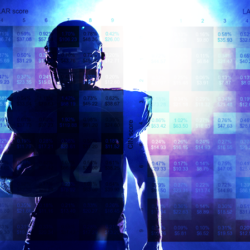
At SIG, one of our main goals is to maximize expected value (EV) on a daily basis. In fantasy football (and all fantasy sports for that matter), the goal is the same, draft players that give us the most expected points. But I propose that there is another variable to consider when drafting your team: volatility.
In the early rounds of a fantasy football draft, most of the players drafted have high floors, meaning we can confidently expect a certain level of production from them (barring injury). They also have relatively high ceilings, meaning we can expect these players to be among the highest-scoring in the league. However, as the draft progresses and all the “best” players have been chosen, our strategy for the rest of the draft could head in a few different directions.
We could choose the best available player (in terms of EV) regardless of position (QB, RB, WR, TE), or we can choose a player that fills a position of need. We could choose a “safer” player that has a higher floor and lower ceiling, or we can choose a “risky” player that has a lower floor and higher ceiling. These risky players will frequently have lower expected point totals than the safer players. But I contend that a lot of the time, it is in our best interest to take the risky player, especially in the later rounds of the draft.
In the later rounds of the draft, you have probably filled your whole starting lineup and perhaps part of your bench. By taking a safer bench player, you are giving yourself bye-week replacements for your starters and insurance against injuries, but little else. Instead, you could take a risky player such as a rookie running back who has a minimal track record to indicate future success but is on a team that presents an easy path to his success.
To relate this to option trading, you are essentially buying a cheap call option. If the player climbs his team’s depth chart and becomes the starter, you have hit a home run (or you are “in the money,” in option trading terms) and can either insert this player into your starting lineup or trade this player to another team to upgrade your starters. If the player does not pan out after a few weeks, you can drop him for another player on waivers, thus either creating another opportunity to find a high-upside player, or inevitably picking up one of the safer players, referenced before, always available on the waiver wire.
While I do recommend taking more volatile players in the later rounds of the draft, there are instances where it is in our best interest to take less volatile, safer players. Let’s say it is the fifth round of a 12-team draft with standard scoring. In the first four rounds, you have taken three running backs (all with some form of risk) and a quarterback. You are targeting a wide receiver now, and you can choose between an established WR (i.e. Golden Tate of the Detroit Lions) and one that has been thrust into a starting spot due to injury of another player (i.e. Davante Adams of the Green Bay Packers). Let’s assume that we have similar expected point projections on these players for the entire season. In this instance, with no other WR on your roster, you are probably better off going with a player like Tate. You cannot really afford to miss on a player in this situation, thus making it in your best interest to go with a safer option.
Considering the volatility of each player in a fantasy football draft could give you the edge you need to win your leagues. A properly executed high volatility strategy, along with well thought-out waiver wire pickups and trades during the season, will allow you to maximize your chances of garnering a top seed and winning the championship.




Subscribe Now
Get each new post sent straight to your inbox